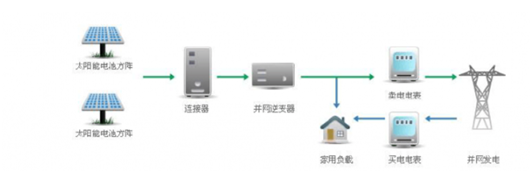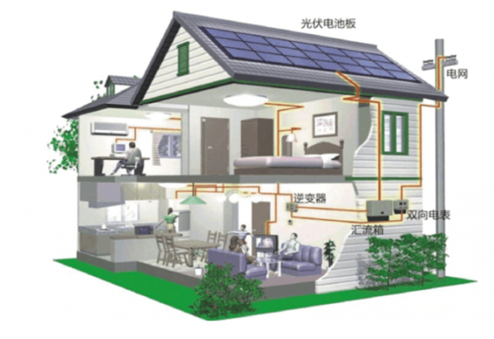.png?v=v1)
.png?v=v1)
2020.12.11
At present, distributed PV power stations are continuously connected to household users, and the State Grid has also issued the opinions on doing a good job in the grid service of distributed PV power generation, which greatly promotes the development of distributed solar energy. In this new energy power supply system, new requirements are put forward for electric energy measurement, that is, it is required to record the electric energy incorporated into the power grid and the electric energy absorbed from the power grid; however, the ordinary single electric meter can not meet this requirement, and the bi-directional energy meter emerges as the times require.
Single direction digital power meter
Electricity meter is familiar to all of us. Every single house hold is equipped with an electric meter. Every month, we need to pay the electricity fee according to the electricity meter. However, the electricity meter installed in household is generally the single direction electricity meter. That is, regardless of whether your connection is forward or reverse, it will be charged to you according to the forward direction. This has a certain significance in reality, and can make up for some shortcomings of some old mechanical electric meters. But it is not very convenient in the application of new PV solar power generation system. In the previous measurement of distributed PV power generation system, two single directional meters were used. That is, one meter is used to measure the electric energy transmitted by users to the power grid, and the other meter is used to measure the electric energy in the power grid. The specific application is shown in the following figure:

What is bi-directional energy meter
The bi-directional energy meter is an electric energy meter that can simultaneously measure the electricity consumption and power generation. The power and electric energy are directional. From the perspective of power consumption, the power consumption is considered as positive power or positive energy, while the power generation is considered as negative power or negative energy. The bi-directional energy meter can measure, store and display electric energy separately in forward and reverse directions. At the same time, the meter can be equipped with standard RS485 communication interface to realize the remote transmission of data.
The application of the Bi-directional energy meter
The bi-directional energy meter is mainly aimed at the users who need two-way measurement in distributed PV solar power station. When the electricity generated by the PV solar power station is surplus, the power transmitted to the grid needs to be accurately measured; when the PV solar power generation can not meet the needs of users, the power consumption of the grid also needs to be accurately measured. However, the common single one-way ammeter can not meet this requirement, so it is necessary to use digital power meter with bidirectional metering function to realize bidirectional metering of electric energy. The application of bi-directional energy meter is shown in the following figure:
In distributed PV solar power station, if the bi-directional energy metering of power consumption and power generation is realized, the traditional way is to use two digital energy meters to measure power generation and power consumption respectively, which greatly increases the use cost, increases the difficulty of wiring, and becomes complex in future use or maintenance. In order to realize remote meter reading, one more communication line and one meter are needed Both increase the difficulty of use and push up the use cost, which is not conducive to a large number of popularization and application; and the use of two-way meters, only a two-way meter can be used to achieve the electricity fed into the grid, and the power consumption of the grid can be measured separately. Compared with the previous scheme of using two one-way meters, the scheme has the advantages of lower cost, less construction difficulty, more convenient maintenance and simpler use, which is also a photovoltaic power station The two-way electric energy measurement based on GIS provides the best measurement application scheme.

Solar PV power generation is a process that uses PV effect to convert solar energy into electric energy, and it is a method of using solar energy efficiently and directly. Since the first solar cell was manufactured in the 1950s, the solar cell technology is still in a period of rapid development. Since it is a conversion process, it is necessary to evaluate the conversion process. We usually use the photoelectric conversion efficiency of solar cells to evaluate the conversion process, that is, the ratio of electric energy to input light energy. The international standard measurement method (ground use, space batteries have other measurement standards) is to measure the output power of solar cells per unit area under AM1.5 illumination conditions, and its value is equal to the conversion efficiency. At present, the highest level of the laboratory is over 42%. The production line level of the factory is about 20%, and it is estimated that the production level in the second half of the year will be greatly improved. Taking the common polysilicon solar cell module as an example, the size specification is about 1.6 m x 0.9 M. if the rated power is 260W, that is to say, when the irradiation power density is 1000W / m2, and its spectral distribution is within the standard error range specified by AM1.5, the ambient temperature is 25 ℃ and the output power is 260W. In the actual use environment, its maximum output power will be affected by lighting conditions, air temperature, wind speed, installation conditions and other factors, generally the maximum power will not exceed 1.3 times of the rated power, the real output power depends on the impedance of the load connected to the output end, which is the significance of maximum power tracking. By this means, the market demand of the bi-directional energy meter will be increase in the coming 5-10 years.
Copyright © 2019.Company Name All Rights Reserved.